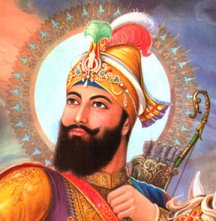|
Khalsa is my Own Form I Reside in The Khalsa Khalsa is my Body and Mind Khalsa is Most dear to me Khalsa is my True Guru Khalsa is my Brave Friend Raj Karega Khalsa  Sri Guru Gobind Singh Sahib Ji 1666 - 1708 FOUNDER OF THE KHALSA PANTH ON VAISAKHI DAY 30th March 1699 The Khalsa Panth or Saint-Soldier was created to annihilate evil, oppression and injustice; to protect the innocent, helpless and the weak; and to uphold the righteousness all over the globe.  To distinguish The Khalsa Panth, Sri Guru Gobind Singh Ji promulgated five mandatory "Articles of Faith", namely: KESH: Uncut hair confirming acceptance of God’s will and wisdom. KANGHA: A wooden comb to care for the uncut hair, a sign of cleanliness. KACHHAIRA: Special type of under garment worn to indicate restraint and cleanliness. KARA: An iron/steel bracelet worn on the right wrist indicating strength and unity, a reminder not to be tempted by greed, lust, love, anger or pride. KIRPAN: A small sword signifying power and dignity.  An initiated Sikh should also follow the Five Vows promulgated by Sri Guru Gobind Singh Ji, namely: 1. Not to Remove Hair from any part of the body. 2. Not to Use intexicants (such as tobacco, alcohol, and drugs). 3. Not to Eat Halal Meat or eat any meat killed according to the Muslim practice. 4. Not to Commit Adultery. 5. Not to Worship tombs, graves, idols and deities.  The above account gives a backdrop to the creation of The Khalsa Panth 300 years ago, at a time when mankind was either faced with the fact of being killed or kill to survive. Sri Guru Gobind Singh Ji overturned this for the Sikhs in one moment by his vision of creating the Sant Saphiae (Saint - Soldier) to annihilate evil, a vision first formulated by Sri Guru Nanak Dev Ji almost 200 years earlier. All Sikhs are eternally gratefull to the Ten Sikh Gurus for bringing an end to the evil regimes being imposed on innocent people whilst the Gurus were alive. Their sacrifices, pains and sorrows can not be measured and Sri Guru Gobind Singh Ji recognised this fact and put a stop to this by creating the Khalsa Panth on Vaisakhi Day. On Sunday 11th April 1999, the atmosphere of Vaisakhi Day of 30th March 1699 was recreated in a quiet suburb of West London. To witness the 300th Vaisakhi celebrations, please follow the links below.   Nagar Kirtan - Sunday 11th April 1999   Changing of The Nishan Sahib Chola Wednesday 14th April 1999.   Celebrating Vaisakhi 1999 to commemorate 300 Years of The Khalsa. 


 |